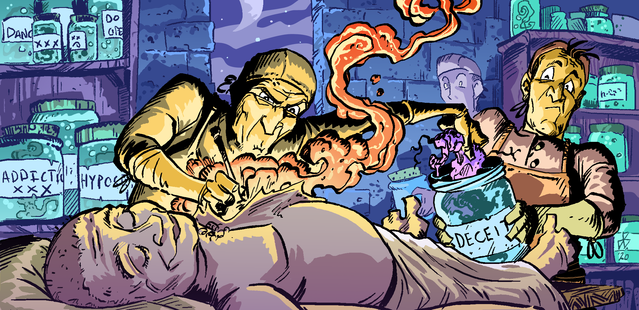Play
Did Psychosurgery Start Out as a Joke?
Psychosurgery began 500 years ago today.
Posted February 20, 2020

The world's first psychosurgery was performed 500 years ago today. No one remembers it was all a joke.
Can you stop addiction or depression by cutting into someone's brain? It sounds drastic, scary, wrong.
But people have done it—and they’re doing it once again. In recent news reports, psychosurgery is touted as a cutting-edge treatment for alcoholism and opioid addiction.
Some experts are more cautious. Dr. Alan A. Stone is the Touroff-Glueck Professor of Law and Psychiatry Emeritus of Harvard Law School and a former president of the American Psychiatric Association. He ended a 2008 Psychiatric Times article by stating:
"The overarching ethical question remains: do we know enough neuroscience to know that we are not doing more harm than good in the long run?"
Some critics say we don't. In their view, psychosurgery doesn't cure an illness; it only "works," they say, by blunting a patient's intellect and emotions. Hence, Stone continues,
"Given the historical burden of the old psychosurgery, the new neurosurgeons have a special obligation to proceed with utmost scientific caution."
In reality, the historical burden of the old psychosurgery is both heavier and a lot more interesting than anyone realizes.
Psychosurgery is no laughing matter. The incredible thing is, it started out as one—as a joke so absurd that all you could do is laugh at it. And since that history has been completely forgotten, it's worth commemorating today, its 500th birthday.

It all started in early 1520, amid the ferment of the Protestant Reformation. That’s when a manuscript began to circulate in southern Germany. Written in classical Latin, it contained a satire titled Eccius dedolatus, The Blunting of Eck. And according to the last page, it was "performed" on February 20, 1520 (acta decimo Kalendas Martii).
The satire takes the form of a play, and the villain of its title is a real man named John Eck.
Born Johann Maier (1486-1543), Eck was a conservative Catholic from the village of Eck and a major figure in the Counter-Reformation. To his Lutheran opponents, that makes him a heretic—and a stubborn one.
In the play, the callous Eck clings to a worldview that his Protestant contemporaries consider backward and medieval. He will not learn from them.
Worse, Eck is irritable, aggressive, always on edge, and he's been self-medicating with alcohol. The other characters stage an intervention for his own good.
What do they do?
They summon a surgeon and task him with saving the stubborn Eck from himself. The operation forms the climax of the play.
Like many thinkers in classical times, the play’s surgeon believes that the breast, not the brain, is the seat of our emotions.
Accordingly, he resects the skin from Eck’s chest, peers inside, and is amazed at what he finds: eight character flaws, each of which he names in turn (read the whole scene here; for the Latin, click here):

- conceitedness (alazoneia)
- manipulativeness (sycophantia)
- narcissism (philautia)
- addiction (asotia)
- hypocrisy (hypocrisis)
- insincerity (kolakeia)
- deceitfulness (apate)
- impulsivity (propeteia)
Looking at these “carcinomas” (as the surgeon calls them), a psychiatrist today might say that Eck suffers from Antisocial Personality Disorder, cluster B. (Check the symptoms here.)
Alarmed, the surgeon decides to ablate some flaws and burn out the rest. He does so, then sutures Eck’s chest back up.
Lucky for Eck, the surgery is a success! He wakes up, says he feels better, and assures the doctor he’s now more cooperative and compliant.
The chorus of the play takes a different view. The satire ends with them declaring the surgeon a misguided fool, and quoting from the Requiem Mass to underline their point:
“You idiot surgeon—attempting an impossible task, a fool’s mission! Trying to restore the sanity and good behavior of a backward theologian! That will happen only ‘when the heavens and the earth shall be moved.’”
Thus ends the play.
There is nothing like The Blunting of Eck in European literature before it, and, to my knowledge, nothing like it elsewhere or after it (Haldipur 2018). As an idea, psychosurgery resurfaces only in the late 19th and early 20th centuries, when Gottlieb Burckhardt (1836-1907) and Egas Moniz (1874-1955) began lobotomizing people they deemed mentally ill. (Moniz later won the Nobel Prize for his efforts.) The rest is history.
What inspired our author to suggest that Eck’s character defects could be surgically excised instead of socially exorcized? Thomas Best, the translator, tells us (20-1):
The name “Eck” (meaning “angle”) suggested to the originator of the plot a condition of roughness, in keeping with Eck's personality, that needed smoothing down. … Since Eck was to be enteckt [“de-edged”] or planed down, more violent treatment was needed.
In other words, it all started with a pun. Eck’s “edginess” had to be “blunted” physically.
Karl Marx quipped that all great world-historical facts and personages appear not once but twice, “the first as tragedy, then as farce.”
Psychosurgery inverts that claim. It appeared in history first as farce, and only later as tragedy. It’s not supposed to happen that way. Yet the historical record is clear.
There’s a curious coda to add. Centuries after The Blunting of Eck had been forgotten, it was reprinted in Berlin in 1891. The preface is dated November 20, 1890. That's the same year Burckhardt was ridiculed for presenting his psychosurgical findings at the Berlin International Medical Congress (Stone 2001, 89).
Maybe it’s a coincidence, but to my mind, the timing of the reprint looks like the work of a troll. It suggests at least one contemporary humanist was alarmed by Burckhardt’s interventions and sought to halt them by bringing this forceful and forgotten satire back to light.
My thanks to Daniel Becker of invisible-ink-studio.com for illustrating the psychosurgery scene (above) of The Blunting of Eck.
References
Cotta, J. F., Pirckheimer, W., Gnidius, M., Gerbel, N., & Szamatólski, S. (1891). Eckius dedolatus. Berlin: Speyer & Peters.
Cotta, J. F., Best, T. W., & Pirckheimer, W. (1971). Eccius dedolatus: a Reformation satire. Lexington: University Press of Kentucky.
Stone, James L. (2001) “Dr. Gottlieb Burckhardt the Pioneer of Psychosurgery,” Journal of the History of the Neurosciences, 10:1, 79-92, DOI: 10.1076/jhin.10.1.79.5634
Stone, Alan A. (2008) "Psychosurgery—Old and New." Psychiatric Times 25:7.
Haldipur CV. (2018) "Addiction: a brief history of an idea." Psychological Medicine 48(8):1395–1396. DOI: 10.1017/S0033291718000314




